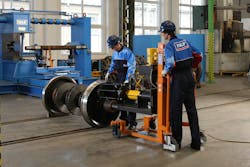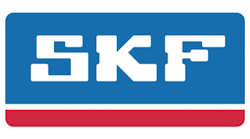Minimizing the number of overhauls for a bogie during the life of a train is key to reducing life cycle cost. Extending the service interval from four to six years can bring savings of about $3,400 per bogie per year.
Looking back more than a decade the wheels were one of the main limiting factors to extend the time between maintenance intervals. Nowadays the use of computer controlled under-floor lathes to remove flat spots and compensate for wear means that a set of wheels can last for more than 1.5 million km before replacement is required.
Until now the bearings upon which those wheels rotate have not been able to meet the longer wheel life. The service life of most components in the bearing, e.g., rings, rollers and seals can even with conservative life calculations outlast a set of wheels by a factor of two, but only if there is enough lubrication. This leads to the critical point. Grease life of railway wheel bearings has long been a weak link in extending bogie maintenance intervals.
Grease is a vital component in railway wheel bearings — it separates the metal surfaces inside the bearing to prevent wear and protects those surfaces against corrosion. The properties of grease change over time, however the base oil component within the grease — which provides lubrication and protection — gradually bleeds out of the thickener that holds it in place. Eventually, the grease is exhausted and must be replaced.
Standard rail bearing units typically require overhaul and re-lubrication every million km, a process that requires the vehicle to be taken out of service and the bearings removed. As the wheel life is getting longer the bearing becomes the limiting component. For operators, these periodic bearing overhauls are a costly and inconvenient maintenance requirement that they would avoid if they could. In an ideal world, bearing overhaul intervals would match the life of the wheel set, so that both jobs could be completed in a single operation.
That situation has become a reality, thanks to an intensive R&D project by engineers at SKF. The company’s latest railway wheel bearing has been designed to operate for 1.7 million km between overhauls, allowing bearing overhaul schedules to match replacement of even the most durable wheels. The SKF team achieved this reduction in maintenance requirements, by focussing on the factors that affect the life of the lubricant within the bearing.
That process began with the lubricant itself. “To maximise the performance and service life of grease, you have to balance the rate at which the base oil bleeds from the thickener,” explained Jan Babka, senior application engineer in SKF’s rail division. “If the grease bleeds too fast, it will quickly become exhausted, but if it bleeds too slowly, it will not release sufficient oil to separate the metal surfaces.“ To find a grease with the best possible combination of characteristics for the wheel bearing application, SKF worked closely with leading rail industry lubricant suppliers.
Having achieved a good starting point, the team then addressed the other characteristics that affect grease life. “Grease life is influenced by a large number of factors, including temperature, rotational speed, bearing size, cleanliness, mechanical churning and other things like the presence of electric currents.” explained Babka. In a railway wheel bearing, most of those characteristics are determined already by the application, but three where we could have a lot of influence are smoother surfaces, cooler running and higher robustness”
Smoother
Even if a rolling surface in a bearing feels smooth when you touch it – it is still not perfectly flat. The surface roughness plays an important role in how much wear and friction is generated. It is important to limit wear since any lose metallic particles can accelerate oxidisation of the grease and shorten grease life. It is also important to reduce friction due to surface roughness since it heats up the grease which in turns reduces grease life. For this reason SKF has refined the surface finishing process of our wheel bearings.
Cooler
Controlling the temperature of the grease required SKF to draw upon its extensive experience of rolling bearing design. “As a rule of thumb, a 15°C increase in operating temperature will halve the life of the grease in a bearing,” explained Babka. “And the main cause of a rise in temperature is friction within the bearing.” The challenge for the SKF engineers, therefore, was to find a way of reducing friction without negatively affecting the strength or operating life of the bearing itself.
Their solution was subtle changes to bearing geometry to optimise the length of the contact between roller and raceway. A long contact gives a high carrying capacity of the bearing but you have to pay for that by increased friction and shorter grease life. The key is to find the right geometry for the right bearing and its operating conditions.. On a typical 130x240 size TBU, SKF’s testing revealed a 30 % reduction in rolling friction, resulting in a drop in temperature of 10°C under normal operating conditions.
Higher Robustness
To ensure that the bearing would not fail even when approaching the service life of the grease when wear can become a problem SKF make use of its patented Xbite heat treatment technology for the bearing rings. Xbite delivers an extra tough "bainite" steel with the same hardness as conventional "martensite" but with higher toughness and longer fatigue life. It also has a higher resistance to wear and a slower crack propagation.
The new SKF TBU is now in production in a range of common sizes. The unit, which is suitable for trains operating between 160 and 250kph, is already in service with one major European rail operator. So is this the last stop for technology development in railway wheel bearings? Babka doesn’t think so.
“1.7 million km is what this industry is asking for today, but there is no doubt that it will always be looking for ways to extend component life and reduce maintenance requirements. In other rail applications, like traction motors, we already make use of other methods to provide even longer grease life, for example through the use of hybrid ceramic bearings. That technology it is too expensive today for large bearings, but it shows that in the long term, it should be quite possible to create a bearing that will run for 3 million km between overhauls.”




